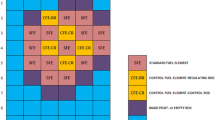Abstract
Precise point reactor kinetic parameters are essential in the study of reactor dynamics. Point reactor kinetic parameters include the effective delayed neutron fraction and prompt neutron lifetime. In this work, effective point reactor kinetic parameters, which can be applied to unstructured grids, were calculated based on the Galerkin finite element method. First, two-dimensional and three-dimensional benchmarks were used to verify the calculation of steady-state neutronic parameters. Then, the Tehran research reactor core was divided into hexahedral meshes, and the forward flux and adjoint flux were calculated. Finally, the effective point reactor kinetic parameters of the Tehran research reactor were obtained by comprehensively processing the steady-state neutronic parameters.











Similar content being viewed by others
References
A. Hébert, Application of a dual variational formulation to finite element reactor calculations. Ann. Nucl. Energy 20(12), 823–845 (1993). https://doi.org/10.1016/0306-4549(93)90076-2
L.A. Semenza, E.E. Lewis, E.C. Rossow, The application of the finite element method to the multigroup neutron diffusion equation. Nucl. Sci. Eng. 47(3), 302–310 (1972). https://doi.org/10.13182/NSE72-A22416
Y. Naito, R. Kawamura, Y. Tokuno et al., A computer program for solving the three-dimensional multigroup diffusion equation by finite element method with 20-node isoparametric element (FEM3DJAR). Prog. Nucl. Energy 18(1–2), 207–214 (1986). https://doi.org/10.1016/0149-1970(86)90027-2
K. Azekura, New finite element solution technique for neutron diffusion equations. J. Nucl. Sci. Technol. 17(2), 89–97 (1980). https://doi.org/10.1080/18811248.1980.9732552
C.Y. Zhang, G. Chen, Fast solution of neutron diffusion problem by reduced basis finite element method. Ann. Nucl. Energy 111, 702–708 (2018). https://doi.org/10.1016/j.anucene.2017.09.044
S.A. Hosseini, N. Vosoughi, Neutron noise simulation by GFEM and unstructured triangle elements. Nucl. Eng. Des. 253, 238–258 (2012). https://doi.org/10.1016/j.nucengdes.2012.08.023
S.A. Hosseini, F. Saadatian-Derakhshandeh, Galerkin and generalized least squares finite element: a comparative study for multi-group diffusion solvers. Prog. Nucl. Energy. 85, 473–490 (2015). https://doi.org/10.1016/j.pnucene.2015.07.009
S.A. Hosseini, Development of galerkin finite element method three-dimensional computational code for the multigroup neutron diffusion equation with unstructured tetrahedron elements. Nucl. Eng. Technol. 48, 43–54 (2016). https://doi.org/10.1016/j.net.2015.10.009
S.A. Hosseini, Sensitivity analysis of the Galerkin finite element method neutron diffusion solver to the shape of the elements. Nucl. Eng. Technol. 49, 29–42 (2017). https://doi.org/10.1016/j.net.2016.08.006
A.V. Avvakumov, P.N. Vabishchevich, A.O. Vasilev et al., Solution of the neutronics code dynamic benchmark by finite element method. AIP Conf. Proc. 1773, 110003 (2016). https://doi.org/10.1063/1.4965007
S. González-Pintor, D. Ginestar, G. Verdú, High order finite element method for the lambda modes problem on hexagonal geometry. Ann. Nucl. Energy 36, 1450–1462 (2009). https://doi.org/10.1016/j.anucene.2009.07.003
M.K. Saadi, A. Abbaspour, Effective point kinetic parameters calculation in Tehran research reactor using deterministic and probabilistic methods. Nucl. Sci. Tech. 28, 171 (2017). https://doi.org/10.1007/s41365-017-0323-7
M. Arkani, M. Hassanzadeh, S. Khakshournia, Calculation of six-group importance weighted delayed neutron fractions and prompt neutron lifetime of MTR research reactors based on Monte Carlo method. Prog. Nucl. Energ. 88, 352–363 (2016). https://doi.org/10.1016/j.pnucene.2015.12.005
A. Lashkari, H. Khalafi, H. Kazeminejad, Effective delayed neutron fraction and prompt neutron lifetime of Tehran research reactor mixed-core. Ann. Nucl. Energy 55, 265–271 (2013). https://doi.org/10.1016/j.anucene.2012.12.001
S.A. Hosseini, N. Vosoughi, M.B. Ghofrani et al., Calculation, measurement and sensitivity analysis of kinetic parameters of Tehran research reactor. Ann. Nucl. Energy 37, 463–470 (2010). https://doi.org/10.1016/j.anucene.2010.01.018
M. Zaker, Effective delayed neutron fraction and prompt neutron lifetime of Tehran research reactor. Ann. Nucl. Energy 30, 1591–1596 (2003). https://doi.org/10.1016/S0306-4549(03)00081-1
B.X Yuan, H. Zeng, W.K Yang et al, Advances in FEMN: the code for nuclear noise analysis based on ICEM-CFD, in Proc. ASME. ICONE26, vol.3: Nuclear Fuel and Material, Reactor Physics, and Transport Theory, V003T02A006, July 22–26, 2018. https://doi.org/10.1115/icone26-81169
K.P. Wang, H.C. Wu, L.Z. Cao, The application of the analytic basis function expansion triangular-z nodal method for neutron diffusion calculation. China. Sciencepap. 10(23), 2774–2778 (2015). https://doi.org/10.3969/j.issn.2095-2783.2015.23.017
A. Hotta, H. Ninokata, A.J. Baratta, Development of parallel coupling system between three-dimensional nodal kinetic code ENTREE and two-fluid plant simulator TRAC/BF1. J. Nucl. Sci. Technol. 37(10), 840–854 (2000). https://doi.org/10.1080/18811248.2000.9714965
Author information
Authors and Affiliations
Corresponding author
Additional information
This work was supported by the National Key R&D Plan Project (No. 2019YFB1901200) and Fundamental Project of NPL, CAEP (No. 232).
Rights and permissions
About this article
Cite this article
Yuan, BX., Yang, WK., Zhang, SB. et al. Calculation of effective point reactor kinetic parameters combined with the Galerkin finite element method. NUCL SCI TECH 31, 69 (2020). https://doi.org/10.1007/s41365-020-00781-y
Received:
Revised:
Accepted:
Published:
DOI: https://doi.org/10.1007/s41365-020-00781-y




